For centuries they have been warming up erotic fantasies. Their history is hidden under the guise of mock shyness. They differed in structure and shape, but all of them were aimed at preventing the inborn "voracity" of the ladies. How much suffering have they brought to women? How derogatory were they? See for yourself the cleanliness review.

A pseudo-medieval caricature of Adolf Willette from the turn of the 19th and 20th centuries, depicting a woman in a chastity belt and a man with a keychain (source:public domain).
Chastity belts have a long history, but it is difficult to know exactly when they first began to be used. According to Greek mythology the first iron panties were forged by Hephaestus for his unfaithful wife Aphrodite who betrayed him with his brother Ares. Because of this myth, this device is sometimes called the Venus Garter.
The beginnings of using chastity belts in real life usually date back to the Crusades. Some researchers argue that men setting out with the cross secured access to their wives in such a way, others - that the contraption was brought to Europe from the Holy Land and hence its alternative name:the Syrian armband. However, we do not have any strong evidence that they were in use in the 12th century.

Illustration of an unknown authorship depicting the chastity belt in Konrad Kyeser's work "Bellifortis" (source:public domain).
According to some experts on the subject the first chastity belt was made at the turn of the 13th and 14th centuries in Padua . The originator was Francesco da Carrara, the city's lord, who prepared iron panties to secure access to his wife. However, nothing but a legend has survived to this day.
The oldest known drawing of a chastity belt comes from a textbook on the art of war. Although the manuscript of "Bellifortis" from around 1405 concerned the ways of waging wars, the above engraving was also included in it. It has only a short description: Front fastened hardened steel belt worn by Florentine women . However, the author does not mention how to get such a fortress ...
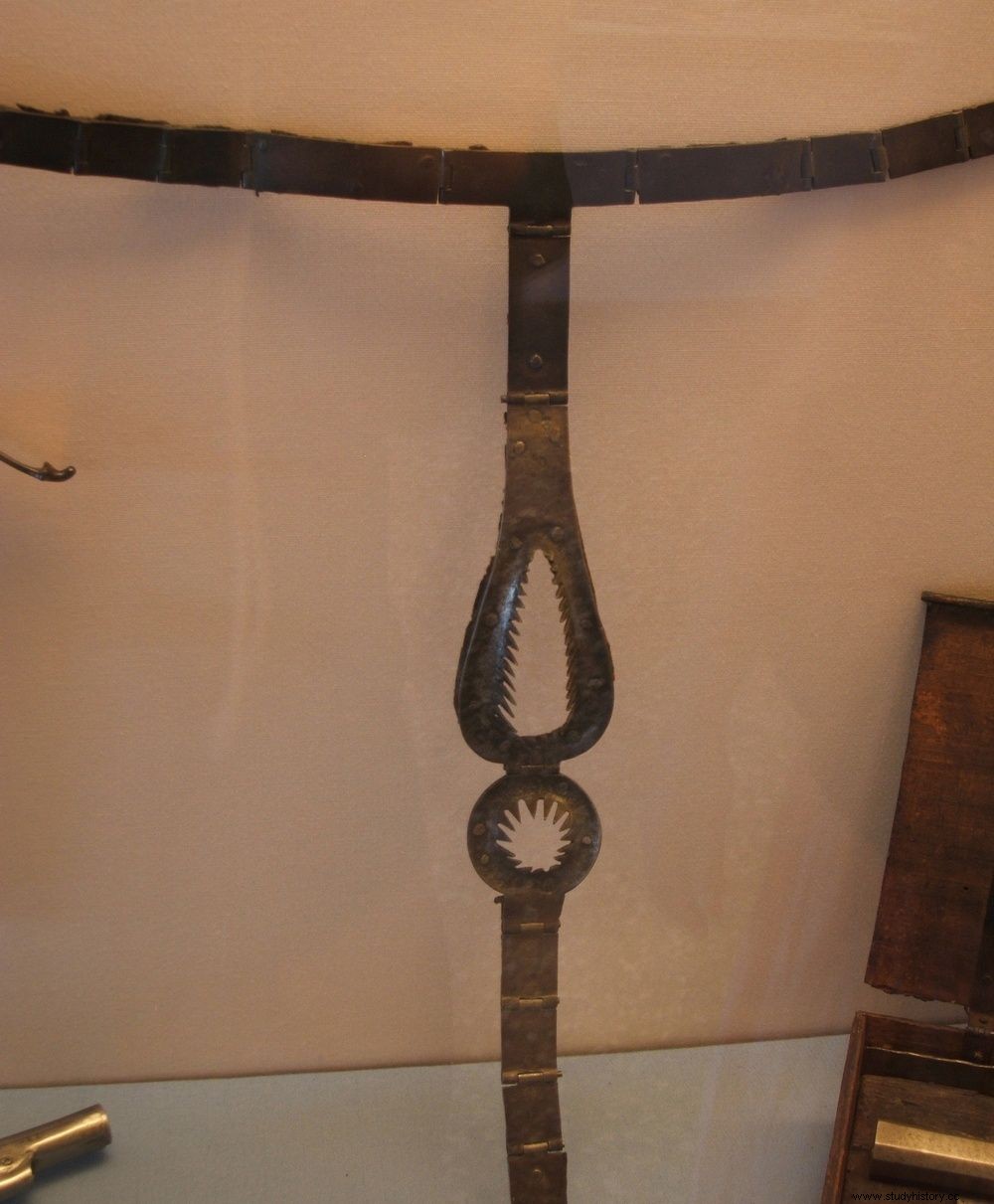
A Venetian chastity belt, probably from the 16th or 17th century, on display in the Doge's Palace (photo:Stevenj, license CC BY-SA 3.0).
The oldest chastity belts that have survived to our times come from the turn of the 16th and 17th centuries. Many of the copies of this guardian of cleanliness, found in European museums, are nineteenth-century fakes. More than once it turned out that the device used as a chastity belt had a different purpose, for example as a muzzle for dogs.
No wonder that the above antique copy comes from Venice - it was the inhabitants of the Apennine and Iberian Peninsulas who were most often victims of the Syrian armbands. In the opinion of the people of the Renaissance, the inhabitants of the South of Europe needed additional protection due to the large size of their crevice . Women of the North could be less afraid of being chained, because the cold closes their organs .
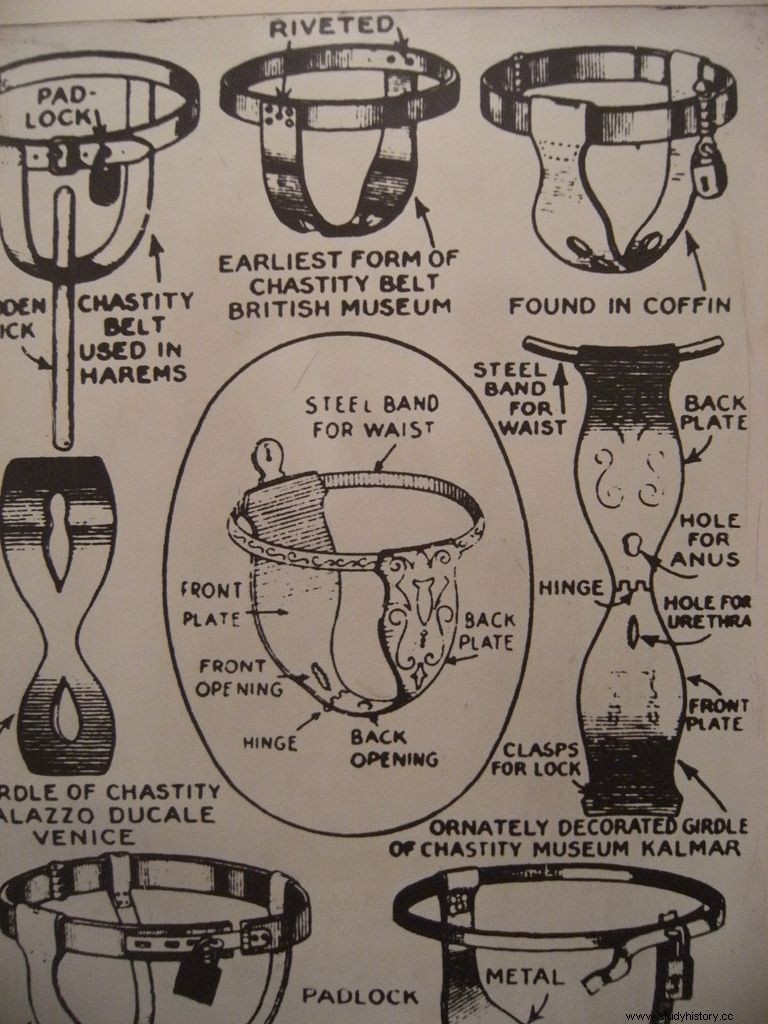
Elements of construction and types of chastity belts in one graphic (photo:Joshua Heller, license CC BY 2.0).
The belts that have survived to our day follow the same basic pattern. They consist of a band on the hips above the kidneys, formed of iron-fastened belts. A metal (less often leather) flexible tape ran from it between the thighs. There was a slot in the front and a hole in the back .
A padlock attached to the belt was an important part of the structure. The latch secret or key was generally held only by the spouse belt bearers. He took him with him on long journeys and to wars, so that during this time his spouse would not accidentally play with someone else. More importantly, she shouldn't get pregnant.
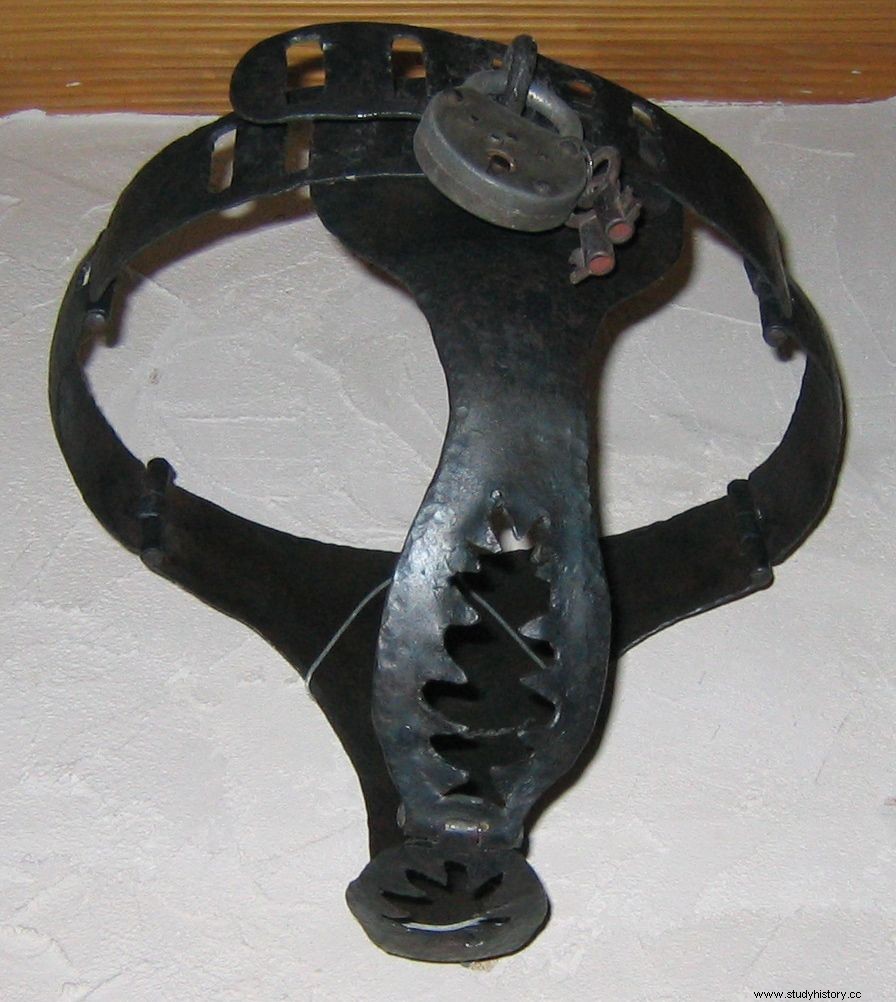
Exhibit from the Museum of Past Torture in Freiburg im Breisgau (photo:Flominator, license CC BY-SA 3.0).
Merely securing the vagina was not enough. The husbands, convinced of the cunning and ingenuity of the woman, surrounded the holes and slots in the chastity belt with sharp teeth. They could cut or even crush a member inserted into it. Thus, they effectively discouraged everyone who was concerned about their nature . They also prevented any other body part from being inserted.
Over time, instead of frightening teeth, Syrian bands began to use more subtle and equally effective ivory darts. They passed between the labia. And they also ensured that nothing could get into the female crevice.

An iron chastity belt, dating from the 16th century, lined (nowadays) with velvet and silk (photo:Wellcome Images, license CC BY 4.0).
Over time, the crude belts turned into craftsmanship. They began to take care of their decoration and the convenience of the user . So far, Kowalska's work has become almost a piece of jewelery. The stripes were engraved on the surface, decorated with gold and silver ornaments. The interior is upholstered with satin or silk for softness.
In the 17th century "Dialogues", allegedly written by Luisa Sigei, there is a description of a gracious husband who wraps his wife's hips with tailored silk. He also decided to add gold chains and prepare a lock and a net with precious stones. This little work of art was to certify that the husband does not hurt his wife, and even pays her tribute .

Chastity belt with a hole for ... heart-shaped feces! A copy on display at the Austrian Hohensalzburg Fortress (photo:Marco Verch, license CC BY 2.0).
The "caring" husbands even took care to vary the appearance of the openings. That is why the back hole was often shaped like a… heart. It did not change the plight of the woman in any way. The metal stuck into the skin and hurt it, and while it slept, the device pressed against the body, causing excruciating pain. Apart from these inconveniences in the chastity belt, an urgent problem was maintaining private hygiene.
Of course, there was no separate hole for monthly blood (as a rule, it was supposed to leak out through a urine hole). The holes that were not too large required a certain "practice" to get everything out of them. Even if it was possible not to leave a fecal, smelly deposit on the inside of the belt, any rubbing or washing was out of the question . Especially that with a belt with teeth you could have injured your fingers.

The plaque under this exhibit rightly indicates that when the husband is killed or the key is lost, the girded woman's situation becomes very complicated ... (photo:Southdevonplayers, license CC BY 3.0).
There have been several lawsuits over the wounds caused by the wearing of chastity belts. One of them took place in Denmark. A jealous husband locked his wife in a chastity belt. For a month, the woman endured the pain. Finally her friends intervened. The woman's husband was summoned to court, which sentenced him to banishment for the cruel treatment of his wife .
In the 18th century, an inhabitant of southern France filed a complaint against her husband who shielded her private parts with pantalons covered with a mesh of brass wires joined by seams. Then he sealed the cover and fitted it with a lock. He made the chastity belt himself, using old chain mail . He made his wife wear this outfit in his absence during pregnancy.

The inside of a closed, silver-plated shell, showing a bearded man opening a chastity belt of a young girl. An item from the Henry Wellcome collection from before 1936 (photo:Ashley Van Haeften, license CC BY 2.0).
The 18th-century logic, expressed in Luisa Sigei's Dialogues, truly written by advocate Nicolas Chorier, encourages wives to voluntarily undergo choking. After all if a woman is virtuous, the belt will not bother her . Otherwise, the husband is doing her a favor by saving her virtue.
Even Voltaire had the opportunity to come into contact personally in his love conquests with the chastity belt. As he wrote, when he was still an ardent youth: Your husband and a despot to your charms slammed the gates on me. Today he triumphantly raises the feathers of the old age, squeezes the key in his hands to our delight . The thinker considered blocking the gates of pleasure to be unacceptable .
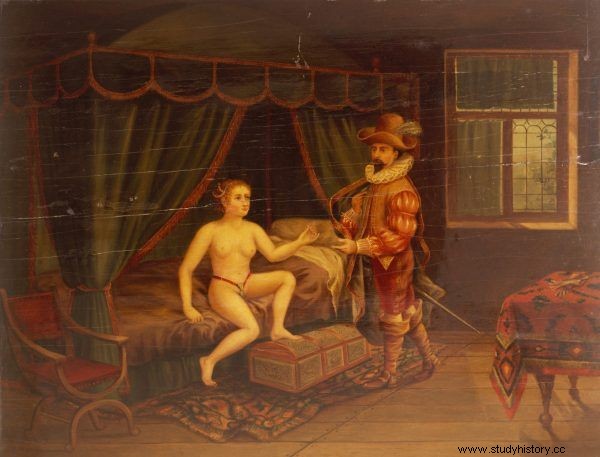
Another girded woman gives her husband the key to her virtue. Oil painting by H. M. Hayman from 1916-1917 (photo:Wellcome Images, license CC BY 4.0).
Not so long ago, in 1892, a French named Hufferte seduced a young girl and then became so jealous of her that he dressed her in a chastity belt. We do not know exactly how this case ended, but newspapers from this period sometimes published advertisements for such instruments.
Even in the 20th century, chastity belts were used. In 1932, a resident of Batavia, New York, persuaded his wife to wear a belt for three months. Fourteen years later, William Truaz of Atlantic City, New Jersey, a carpenter, in his spare time ran a steel chastity belt manufacture.

A prototype of the previous painting, although with a completely different overtone. Caricature from around 1590. In the central scene, the wife gives her husband, who is going on a long journey, the key to the belt (author:Heinrich Wirrich, source:public domain).
Chastity belts in art soon became a motive for mocking male naivety . This was the purpose of the satirical drawing above. In the central scene, the wife gives her husband, who is going on a long journey, a belt key. Thus, he shows submission, loyalty and reconciliation with fate. Are you sure?
On closer inspection, the old woman in the background has a copy of the key ... She is accompanied by a young, elegant man. He seems to be getting ready to replace his spouse in handing out hugs to a beautiful lady. The whole thing is a satire on a husband who is not protected from horns even by the chastening of his wife.

A 16th-century German satirical drawing showing a woman in a chastity belt with her husband and a lover (source:public domain).
The chastity belt was an expression of male fantasies. It symbolized their claim to power and exclusivity over the spouse's body. By the way, confirmed the belief in innate feminine promiscuity . After all, the ladies were capable not only of mere cheating, but also of masturbation, lesbian contact and zoophilia.
Women, seductive by nature, were to have an "open" nature into which every thing and creation could enter. The men felt the need to plug this fissure, at least in their imaginations . And philosophers and theologians only fueled these concerns.
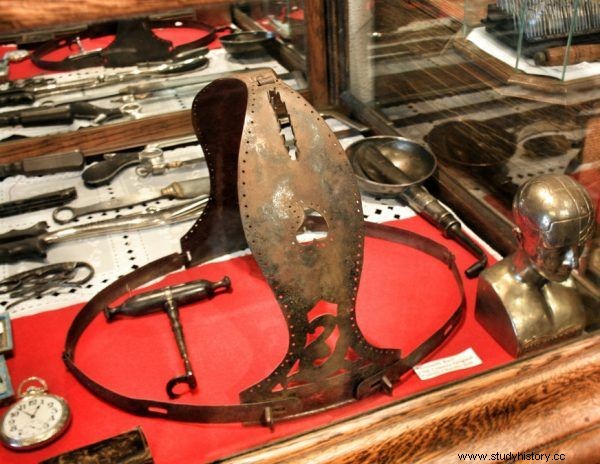
19th-century chastity belt (photo:Maya West, license CC BY SA 2.0).
Chastity belts were rarely seen. They really existed, but they appeared much more often in the literature and imagination of the people. Only the cruelest and most obsessed with the vision of infidelity forced their wives to wear these instruments. Only a few hundred European women had to bear this unfortunate burden. Embarrassment, discomfort, humiliation and often painful abrasions - this is the terrible price of the guarantee of exclusive access to their body.
Belts did not have much to do with the positive aspect of cleanliness, but much to do with double morality and the concept of male domination over the female body . This armor, placed on the genitals, was a threat constantly hanging over the women. He recalled that cleanliness was their duty. Sexual freedom was only the privilege of men.
***
Diane Ducret's book, Forbidden Body was the inspiration and source of descriptions. A story of male obsession, The Horizon 2016 sign. The following were also used as an auxiliary:
- Elizabeth Abbot, A History of Celibacy, Dolnośląskie Publishing House 2003.
- Guy Bechtel, Four women of God. Loaf girl, witch, saint, stupid goose, Ed. Academic Dialog 2001.
- Stephen Harris, Bryon L. Grigsby, Misconceptions About the Middle Ages, Routledge 2010.
- Waldemar Kuligowski, Love in the West. Anthropological history, Ed. Science. AMU 2004.
- George Monger, Marriage Customs of the World:An Encyclopedia of Dating Customs and Wedding Traditions, ABC-CLIO 2013.
